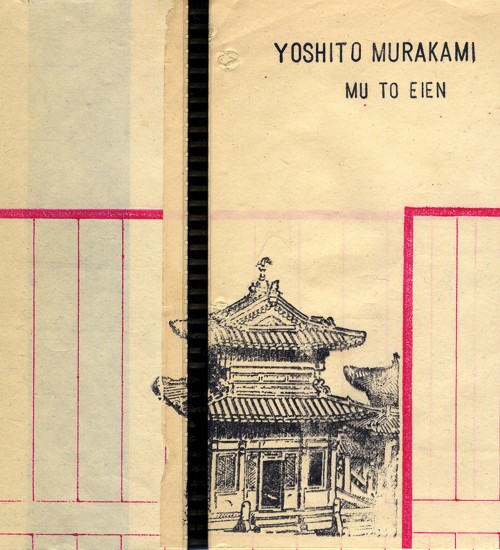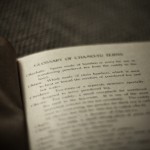

Radioaktivna ljepota industrijskog uzgoja cvijeća i leptira u Japanu.
soundcloud
This is is a full length release from Japanese ambient/drone artist, Yoshito Murakami. Like Japan itself, and like nature and it's seasons as well that have inspired this music…beneath the conceptualized beauty and melodies there is always an unforgiving inner truth, and industrial reality. The din of the cicada gives way to the piercing whine of the industrial machine, and the falling and clattering of the cherry blossoms fade…
Each copy of this release, entitled "Mu To Eien", comes in the form of a handworked, stamped, assembled and sewn, 6" square booklet of antique Japanese paper ephemera, old fold out tissue maps, Meiji era apothecary ledger pages, and a double sided insert printed on bamboo. Each booklet is banded with a length of a vintage 8MM film depicting the great Japanese earthquake of 1923. Each will come in a lovely "clouded" translucent vellum envelope, spattered with cherry blossoms.
Time Released Sound, you’ve really done it now. This is the most preposterously packaged CD I’ve seen in quite some time. For your thirty-odd quid you get handworked, stamped, assembled and sewn, 6" square booklet of antique Japanese paper ephemera, old fold out tissue maps of Japanese locales, Meiji-era apothecary ledger pages, and a double sided insert printed on bamboo veneer. Each sewn booklet is banded with a length of a vintage 8MM film depicting the great Japanese earthquake of 1923. Each will come in a lovely "clouded" translucent vellum envelope, spattered with fluorescent cherry blossoms. You couldn’t make it up could you?
Retailing at £32.99 and limited to 100 copies this has obviously cost around £2000 to produce, which begs the question, why not just do it on lovely vinyl? Do people really need all these bits of paper however lovely and well put together they are? I shouldn’t gripe - masses of work has obviously gone into it. Similarly lovely and well put together is the music (yep, somewhere within it all is a CD). It’s full of the most wonderful drones and gorgeously picked acoustic guitar textures all melted together in a stunning drifty masterpiece of sound. It flutters, it stutters, it sounds like all manner of Japanese soundsmiths and has something of the gentle floral beauty of its countryside within the grooves, along with the weird eerie hum of its factories. Utterly lovely. - Norman Records
Not long after the cradle, our young fingers reach out for peace and innocence. As the body develops, so too do the buried human emotions of greed, jealousy, anger, the need to put others down; all of these things afflict not only the body, but the soul. So what went wrong! Just as with the suggested power struggles inside The Vatican, of all places, human beings, regardless of cause or situation, can fully appear the darker sides of human nature like an unwelcome apparition. Our slightly sadistic urge to wipe-out, or at least to flirt and threaten disaster, is still among us to this very day – look at North Korea launching their own nuclear weapons, an act of unbelievable hostility, yet sticking to the rather tame excuse of (non) American aggression.
Industrial growth is but one area spawning this darker side of the soul; a very human desire for greed, control, domination, enslavement and manipulation of equals. Above all is the love of money, provider to all of the above. Since the industrial revolution, predictions of increased industrial growth have proven true. They may be the first steps towards our own downfall, and yet we are, thankfully, still a long way from losing the luscious greens and brilliant blues of nature entirely. As of now, the natural landscape still prevails, although it’s under threat from suburbia in a way never faced before. In the 21st Century, it can escape remembrance that nature was here first, and if we continue to flirt with disaster, she will be here lastly. Your escape route this week leads to Japan – Mu To Eien – and it arrives courtesy of Japanese ambient-drone musician Yoshito Murakami. Instilling the unique, natural Japanese paradise with the creeping hold of 21st Century machinery and robotic, monotonous industry, Japan’s way of life is, like the West, in a state of constant flux with the advance of technology. Murakami clearly holds an undying passion for the preservation of Japanese culture; clinging onto the traditional cherry blossom roots are the cold, iron clanks of a newly built robotic, electronic arm that wishes to overtake the national symbol of love, identity and remembrance with an unemotional selfhood of its own. Murakami not only explores this new-found, anxious relationship through ambient excursions, but in so doing also raises awareness of the potentially cancerous path advancing into society.
Nowadays, the tranquil traditions of Japan are no longer immune to a peaceful way of life; susceptible to the incessant surge. As is so often the case, when the two life ideals collide, they bleed and conflict with each other violently. Japan’s recent nuclear disaster in Fukushima – the largest nuclear disaster since Chernobyl – should be a warning. As well as the expected negative fallout suffered, a recent report claims that residents living around the plant are now more susceptible to developing cancer. Acts of nature – in this instance an earthquake provoking a tsunami – can be partly responsible, but the nuclear element of the already-disastrous events wouldn’t have existed if the plant itself – a human element – didn’t exist. A butterfly effect takes place – radioactivity once restricted to the inner confines is simultaneously released, spilt into the precious ocean (debris from the tsunami recently washed up on the Hawaiian coast.) The ocean absorbs the poison and the fish inhale it. The fish are then killed and the radioactive material enters the food-chain; people previously unconnected to the events fall ill and become infected. It’s a vicious progression, due, in part, to the modern, insatiable thirst for industry.
Electronic signals are never far behind the natural atmospheres, almost as if they are traces of leaked contamination; they rise to the fore with the experimental, cold workings of unknown devices, meticulously repeating and never losing a beat in their pinpoint accuracy. Murakami doesn’t place industry in any negative light, in a way that doesn’t put in danger the disposing of the past. Stretches of stunning ambient vistas, as seen in ‘Light of Shadow’, are shaded by slowly ascending piano passages. A light not shadowed at all, but golden; it steps out of the shadows triumphantly. A sparkling drone is placed above all, courting the eye in a fountain of wonder – when we were forever young.
Murakami always returns to his sheet of ambient-drone; she drapes herself over the music prominently, and this ensures that the ambience is Queen above all. Entire dissipate the threat of technology over the ancient land of Japan, where the sun may rise once again. In a country known for its electronic innovations, the ambient textures never lose face. They’re always gorgeous to listen to, whether set in the city or in a forest – they’re just different. The fourth entrant is just divine. ‘Mizuno Shimidashi’ is pure peace and beauty. Murakami’s ambient textures are coated thickly, and this time an inquisitive acoustic guitar comes out to play. This is a thousand miles away from a nuclear zone. Instead, the atmosphere is inviting towards the presence of the sun. Unfolding as they wish, like flowers of spring-time, the petals of drone are pretty in pink.
‘Quiet Summer, White Mountain’ is such a trek through alpine reserves; a space all of your own – both the inner and outer kind – where you can scent the quality and the fresh taste in the air. Rising melodies settle down and the mood turns cooler, arcing the music like an arrow into increasingly ambient areas. A fragile interplay reveals flowering petals, unaffected by the country’s new look, victoriously.The sound of running water eases you into deep relaxation only a stepping stone away from meditation. No technology intrudes. Later intervals arc to the point of warping, wavering in pitch – as if they know something isn’t right with their environment.
Advances in technology are only a ripple on the lake of existence; nature will claim back whatever may rust. Just like Murakami’s draped atmosphere of peace, aided by his tranquil touch over the piano and the relaxed reverb running alongside her, this peace is an infinite one, unbroken by the city. The natural world is the everlasting way. It calls – yearns deeply – for a return to a life that hasn’t surrendered to technology; a simpler life. And yet, the bittersweet paradox is that Murakami’s statement would not be possible without advances in recording, and electronic, technology. We must be thankful, too. Music, and humanity, face the necessity of learning to live in harmony, as one.
Flirting with disaster, Mu To Eien comes complete with a vintage 8MM film featuring the great Japanese earthquake of 1923 – another disaster, on a purely natural scale. Sweetly counteracting the disaster in the soul is a clouded, translucent envelope, spattered with beautiful, fluorescent cherry blossoms. - James Catchpole / Photography: Daniel Crossley












Nema komentara:
Objavi komentar